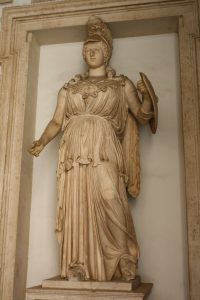
A 2nd century BCE statue of Minerva, now housed in the Capitoline Museum in Rome.
Minerva was the Roman deity of wisdom and warfare, as well as a patron of the arts. A prophecy was told to Jupiter that his relationship with the Titaness Metis would bear a child powerful enough to overthrow him. In response, Jupiter swallowed her to neutralise the threat. However, Metis was already pregnant with Minerva and set about crafting armour for her daughter. This forging gave Jupiter a headache and he persuaded Vulcan, the god of metallurgy to split his head open with a hammer. As a result, Minerva emerged from the cleft bearing the armour and weapons of her mother.
Minerva was originally a local Italian deity, worshipped for her patronage of arts and crafts. Her worship was then adopted by the Etruscan civilisation, who knew her with the Old Latin name of ‘Menrva’ and adopted her into a triad of deities. In this role, she was again the goddess of crafts, weaving and music. From approximately the 2nd century BCE the Romans began to equate her with the Greek goddess Athena, fashioning her as their goddess of wisdom, battle, and medicine alongside her handicrafts. Unlike Mars, the Latin god of war, Minerva was shown with her sword lowered in sympathy for those lost rather than raised in triumph. Nevertheless, she was absorbed into the Roman Pantheon and included in the Capitoline Triad made up of Jupiter and his wife Juno.
The worship of Minerva expanded throughout the Roman Empire, with her worship in areas such as Britain being linked with the local deity Sulis. Sulis was a Celtic healer and solar deity who presided over natural springs, and who later became known as ‘Sulis Minerva’. This link to healing spread to Rome in the form of ‘Minerva Medica’, the goddess of medicine.
As the goddess of war and member of the Capitoline Triad, Minerva took over the patronage of the Quinquatrus Festival from Mars. The festival was held over 5 days starting on the 19th March, with the first day commemorating the consecration of her temple on the Aventine Hill. The remaining four days are believed to mark the beginning of the campaign season for the Roman army, and were celebrated with gladiatorial games. Her worship was important to the Roman people, with General Pompey the Great dedicating a temple to her following successful campaigns in the east. Similarly, Emperor Domitian claimed Minerva as his protectress and commissioned a temple to her to stand in the Nerva Forum in Rome during the 1st century CE.
Yet her original links to craftwork were never forgotten. In either 263 or 262 BCE, a shrine was created on the Aventine Hill in Rome in her honour. From 207 BCE, this shrine became the location of a guild of craftsmen who would meet to make annual offerings to the deity and became an importance centre for the arts during the middle of the Roman Republic.
In his Metamorphoses, Ovid told of Minerva in a dispute against another who claimed to be of superior skill. In the myth, Arachne boasted that her weaving skills surpassed the deity which angered her. In response Minerva challenged her to a weaving competition. They each sat alongside each other at their looms and began working on a tapestry to outshine the other. Minerva’s showed a depiction of the gods and showed herself as the victor in a battle against Neptune to become the patron deity of a city; like that of the battle for Athens between Poseidon and Athena. Arachne showed the gods taking multiple forms to seduce unsuspecting mortals. While the work was believed to be of magnificent quality, Minerva declared herself the winner and transformed Arachne into a spider. This was a popular cautionary tale to the ancient Romans, as it showed that it was unwise for mortals to consider themselves equal to the gods.
Minerva, like Athena, was often shown with an owl for her sacred creature as owls were believed to represent wisdom. Both her and her owl have been seen on the coinage of multiple Roman coinage.
-Devon Allen
Junior Girl
Girl Museum Inc.
